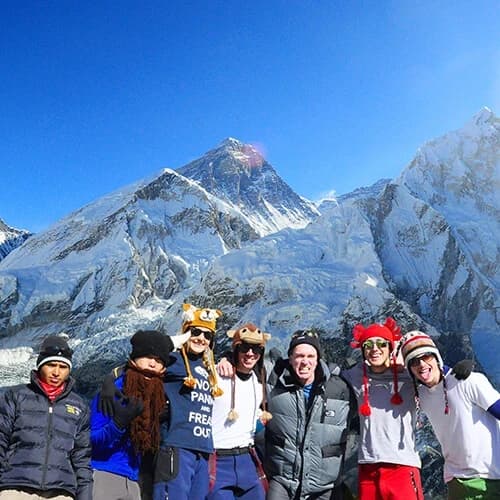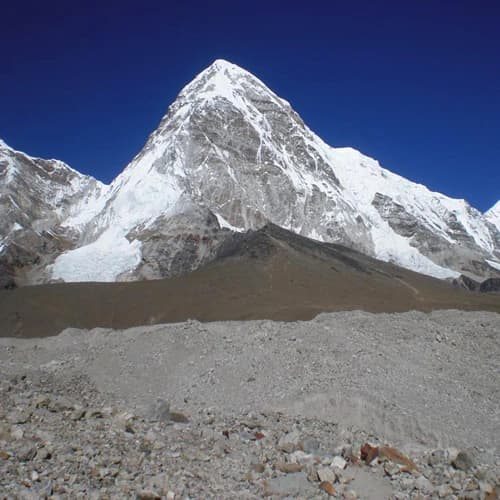Highlights of Trekking the Everest Base Camp in July
- An excellent trekking environment with clouds that largely block the sun's heat
- Stunningly adorned flora and lush, verdant woodlands
- A stunning vista of the mountains appears after the rain has cleared the air
- Isolated trails, leaving all the scenery to yourself
- More lodging options without requiring early reservations
- Readily available Lukla flights, albeit the weather could make flying difficult
- An adventurous excursion for experienced hikers
- Enjoying the fun-filled Rice Plantation festival in Nepal
What does the Everest Base Camp Weather and Temperature in July look like?
July is the middle month of the monsoon. So, there is a high chance you'll encounter rain on most days. The early days in July will have lighter rain instances. Likewise, sporadic rainfall without a significant downpour is possible during mid-July. Similarly, the latter days feature lots of rain and clouds. You can continue to hike during light rainfall, but you have to take a break and take shelter if it gets heavy. The optimal time to begin your trek in July is in the first few weeks.
It's crucial to keep in mind that precipitation is less likely to happen at higher elevations. Since we begin the trek from Lukla at 2846 meters, remember to finish the first few days of the trek while the rain hasn't yet started to fall in full force. The likelihood of torrential rain decreases as you approach Namche Bazaar (3440 meters). Rain frequently falls in the late afternoon and evening, especially at lower altitudes. You're safe if you go out on your hike early in the morning and finish it before the rain starts to fall.
In July, the Everest Base Camp experiences average temperatures ranging from -2 to 15 degrees Celsius. Additionally, the temperature fluctuates according to the altitudinal zones. The temperature drops a bit with each day of ascending. For instance, in July, the maximum temperature in Lukla is often approximately 18 degrees Celsius, whereas Namche Bazaar, Lobuche, and Gorakshep experience temperatures of roughly 16 degrees Celsius, 11 degrees Celsius, and 8 degrees Celsius, respectively.
The temperature may fall dramatically when it starts to rain. Wearing layers of clothing with a waterproof outer layer is recommended to stay warm and dry during rain. Wear a good-quality down jacket during the day to stay warm indoors. Additionally, the temperature at night may drop significantly, so bring a thick sleeping bag to keep yourself warm and sleep comfortably.
This month's days are longer, and nights are shorter than those of other seasons, with 7 to 8 hours of daylight on average per day. It's the ideal month to start your hike in the early hours before the sun rises so that you can complete it before it rains in the late afternoon.
Similarly, the Everest region's average wind speeds in July range from 5 mph (8 km/h) to 10 mph (16 km/h). Compared to night, the day is warmer, sunnier, and less windy. You should bring some insulating clothing because it can get chilly in the evenings.
What are the Benefits of Trekking to Everest Base Camp in July?
July may not offer many compelling reasons to visit EBC because it is an off-season. But it's the best month for dedicated explorers who want to feel the excitement that so few dare. There isn't a finer month to go on a trip to the Everest region than July if you're attracted to the pristine splendor of raw nature. Let's look at a few benefits of taking the Everest Base Camp trip in July.
Shades of Monsoon Green
The monsoon season is when the Everest trekking region comes to life, and the native flora and animals will catch your eye. You might not see the Himalayas clearly during your trek on foggy days. However, on bright days, the sights seem more distinct than ever. The slopes and hills are draped in lush green carpets during this month, and the ground has a wonderfully fresh aroma. You'll see greenery everywhere you look. The distinctive flora and beautiful scenery make it a fantastic hike in the monsoon. You get to discover unique plant species that abound throughout the pathways. There may be times when you feel like you're walking in a natural meadow. That's how lovely it is!
Adventure in the Wilderness
Wilderness adventure is possible during the July trip to Everest Base Camp. This is because the Everest region's scenery and climate in July are unlike anything else. You might have to hike through the rain on the slick trail. With the possibility of landslides in the lower Everest region, the EBC trek, which is always an adventurous route, is much more exciting by monsoon rain. In erratic weather, you will go through some of the roughest and most difficult terrain. It takes a courageous person to set off on such a journey. Your bravery will amaze people on the challenging July hike. Trekking in July is far more adventurous than trekking in peak seasons when the weather is often good.
Enjoy the Journey in Solitude
As previously said, July is not a popular month for trekking. As a result, you might be one of the few persons on the trail. You may enjoy the walk in isolation because you won't often run into other hikers. It is said that less than 1000 people make a trek in the Everest region in July. If you enjoy taking quiet walks in the wilderness, now is the ideal time to go trekking. If privacy is what you seek, you ultimately get it! Imagine going on a hike in a massive mountain range with no one else around to disturb your blissful experience. Isn't it amazing?
Access to Accommodation is Easy
Since there won't be many trekkers in the area, it goes without saying that there won't be many at the teahouse settlements, allowing you to choose the most excellent accommodations for yourself without having to make reservations. Finding lodging in the Everest region during busy times is a headache. But it seldom ever occurs in July! Similarly, you will find it easier to satisfy your demands because there will be significantly fewer guests to accommodate. However, because there are fewer visitors, most teahouses are closed during the off-season. You won't need to worry, though, as each village will have at least one teahouse open, which is more than enough to accommodate all the trekkers.
Witness the Unique Rice Planting Festival
This is a distinctive celebration that's observed in Nepal's lower hills. It normally happens at the end of July or the beginning of July. Farmers typically begin planting after rain on the day of the rice planting festival. People consume the regional dish "Dahi Chiura," which consists of beaten rice and curd sweetened with banana or sugar. People sing traditional folk songs and dance on this day in the soggy field where the rice plants are being planted. They delight in the fun together. They enjoy each other's company in the rice fields. You get to have this amazing experience in July, which is terrific!
Matter of concern while trekking to EBC in July
- Your trek to Everest Base Camp may become a little more difficult in July if you pass through any areas that are prone to landslides. On such trials, exercise caution.
- Due to the rain this month, the track may be a little slippery. Bring the appropriate shoes and take additional caution to avoid falling and harming yourself.
- Leeches may be aplenty in the lower frets. Keep leech-repellent lotions and ointments on hand.
- The weather may become quite unpredictable in the Himalayas, particularly in the Everest region in July. Due to severe weather, the Lukla flight may be postponed or canceled. Make sure your schedule has a few additional days.
- Get ready for the prospect of thunderstorms in the area.
Is hiring trekking guides and potters necessary for the July trek to EBC?
In contrast to other trekking areas, the Everest region does not require visitors to hire a trekking guide compulsorily. You may therefore start this adventure on your own. If it were a good time of year, we wouldn't insist that you hire a guide. However, going on a trip without a guide in the Everest region out of season is very dangerous. Because of the bad weather, you won't even find people on the route to ask for anything you need. The fact that you don't speak the language and the linguistic barrier will cause trouble in doing even routine things like finding the route. Therefore, we highly advise you to take a knowledgeable guide with you on this challenging July journey. Your walk will be more pleasurable and secure if you have a guide with you because they are skilled at responding quickly to adverse weather conditions or medical issues.
It's entirely your decision regarding hiring porters. If you're an experienced hiker and have gone on multiple high-altitude treks, you may even be able to make it without a porter. However, porters make the experience considerably more comfortable as they will transport the majority of your gear from the start of the walk to its end. The rainfall exacerbates the challenging trekking terrain, which is already difficult. Carrying a large backpack by yourself is a recipe for disaster. Therefore, we advise hiring a porter, especially in July.
Some Tips for Your July Trek to Everest Base Camp
- You can go on your trekking journey on your own, but given the conditions and terrain, it can be quite dangerous. We recommend getting a guide!
- If you have a porter with you, the trek will be rather simple.
- Having rain gear like raincoats and umbrellas is quite helpful during the July journey.
- Only go on a trek with a reliable tour company.
- Check all of your necessary gear and equipment again.
- Check the weather prediction every day prior to starting the hike.
- Bring a few extra days with you as there are chances of Lukla's flight cancellation, and you might have to take breaks on your itinerary due to heavy rain.
- Ensure that your trip insurance is active and that it includes helicopter rescues.
Packing List for July trek to EBC
- Rain gear (raincoat or rain cover)
- Trekking shoes with sturdy soles
- Camp shoes (Sneakers or Sandals)
- Trekking poles
- Backpack and a day pack
- Thick sleeping bag
- Good quality down jacket and pants
- Waterproof windcheater jacket and pants
- Hiking T-shirts and pants
- Fleece jacket
- Thermal wear
- Extra clothes for layering
- Undergarments
- Woolen caps
- Gloves
- Thick socks
- Basic First Aid Kit
- Water bottles with purifying pills
- Guide Book with a Trail map
- Toiletries
- Moisturizer
- Sun Cream
- Sun hat
- Scarf
- UV Sunglasses
- Energy bars
June, July, and August in Nepal are considered the monsoon season. You will then experience the wettest weather this country has to offer. However, it is also a season when the Nepalese Himalayan foliage is decorated in many hues of green. Although it does rain most days during the day, the situation is not as awful as it seems. If you have proper rain gear with you, you can travel! Monsoon trekking is a rare adventure that few people take part in. But once you get going, this will be one of the most memorable moments of your life!
We sincerely hope that this blog has given you the knowledge you need to trek to EBC in July. Every season is distinctive in some way, and it is possible to Trekking to Everest Base Camp all year long. You thus have a fresh experience each month. The best course of action is for you to conduct thorough research and plan your voyage according to your tastes. You'll maximize your trek's benefits if you do it that way. Trekking to Everest Base Camp is an opportunity of a lifetime that might be difficult due to monsoon conditions. But if travel doesn't offer excitement and adventure, what good is it?
Keep Outfitter Nepal in mind if you consider joining this expedition in July. We will provide you with a knowledgeable guide to make the journey safe and enjoyable. You won't have to worry about anything because we'll take care of everything, including the flight to Lukla, trekking permits, lodging, and food while you're on the trail. You can contact us by email or Whatsapp; we'll handle the rest. Have a great trek!
Some Most Popular Treks




